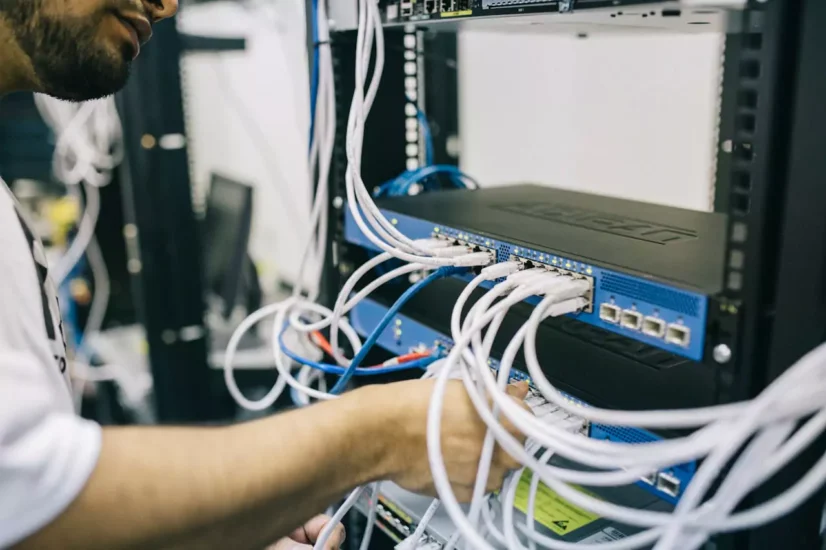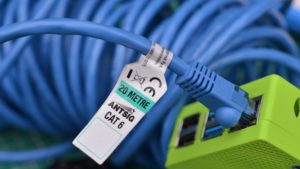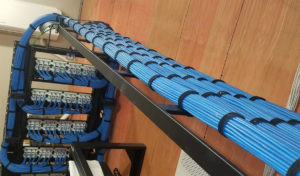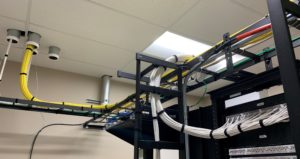Cabling infrastructure is the backbone of every modern office, and getting the most out of it requires deliberate planning. When cabling infrastructure is effectively planned and installed in a new office, it provides stability for a company’s voice and data systems. Well-planned cabling infrastructure also prepares a new office for new technologies and network expansion.
New office cable planning specialists are specifically trained to install network cabling. They can bring more knowledge and experience to an installation than general maintenance staff. Cabling specialists are particularly valuable at the planning stage because they understand how to mitigate potential issues. They know how to conduct a site assessment, develop workarounds for logistical issues, ensure compliance, minimize costs and keep future needs in mind.
Put simply, investing in office cabling specialists produces long-term value by ensuring superior network capabilities.
Well-Planned and Strategic Network Solutions
New office cabling planning must be part of any strategic network solution. A well-planned cabling infrastructure is based on an initial site assessment. Keeping costs in mind, cabling specialists can identify design issues and adhere to compliance standards. Cabling specialists can then assist with every aspect of the installation, including cable routing, termination, testing, patch panels, racks and cable raceways.
Initial Assessment
A strategic network solution starts with examining the layout of the new office and any existing infrastructure. An initial assessment should also consider current needs and potential future requirements. By identifying restrictions and potential interference, new office cabling planning specialists can lay the foundation for a network that minimizes interruptions.
Cost Considerations
Cabling specialists can also help a company avoid unnecessary costs and keep the project within budget. These professionals can use their experience to optimize materials, avoid common pitfalls and cut out unnecessary steps. For example, if an office is a new building or getting renovated, it is cheaper to run cables through the walls and ceiling while they are open. It's also much more expensive to install cabling after a new office is in use, which can lead to workplace disruptions.
Develop a Smart Design
Placement, cable lengths, routes for potential expansion and other factors are all critical to a well-designed cabling infrastructure. New office cabling planning specialists have the experience to spot design opportunities and incorporate some flexibility. A smart design can prevent delays and avoid the need to rework misplaced infrastructure in the future.
One common design mistake is to underestimate the number of cables. This is because the number of employees in an office tends to grow over time. This results in the need to call back installers to put in more network links, which is much more costly than installing all the links needed during construction. Cables are relatively cheap compared to labor, and it costs the same for a technician to put down two cables compared to one.
Following Industry Standards
Any cabling installation should follow the established ANSI/TIA & ISO/IEC standards. These specifications are meant to support performance and dependability. For example, they mandate that cabling must be backward compatible, which means they must be able to work with order cabling technology.
New office cabling planning specialists understand these standards and how to apply them. Not doing so could lead to additional work and delays.
New Office Cabling Infrastructure
The physical installation of new office cabling involves many different factors. At the bare minimum, it should ensure that there is minimal interference and crosstalk. Smart installation can also facilitate and expand in the network and reduce the need for future maintenance. It's also critical that installers follow all building code requirements.
In addition to cables, there are many other components to office cabling infrastructure. The use of cable trays and conduits is fundamental, as they help to maintain efficiency and minimize signal degradation.
Patch panels are used to connect voice and data connections to a network, organizing these connections in the process. These panels must be accessible in order to simplify troubleshooting. The smart placement of patch panels can facilitate future changes or expansion of the network.
An installation of new office cabling infrastructure must use space efficiently. Racks that hold networking equipment and patch panels help to optimize space and should be well organized. Neatly organized racks not only look nice, they also make equipment more accessible for maintenance and troubleshooting.
New office cabling planning specialists also use cable raceways to protect and hide away cables. Raceways help to minimize cabling as a safety hazard and they also help with aesthetics. When raceways are being installed, it is important to consider accessibility, cable capacity and maintenance. When installed correctly, raceways prevent damage and support future scalability.
One of the most important aspects of any installation is the proper termination of cables. Cables must be precisely terminated to ensure the security and longevity of each connection. Cabling infrastructure is expected to last many years, and proper connections are important to ensure that cables maintain a high level of performance over the course of their expected lifetime.
After cabling has been completely installed, technicians then perform extensive testing to assure that the entire infrastructure is ready to handle all of an office’s expected network traffic. Thorough testing insurers both optimal performance from Day One, and also supports long-term network performance. Cabling specialists also perform the tests with an eye toward emerging technologies that an office may adopt in the coming years.
Helping Your Business Move Data Systems
If your company is moving its existing cabling infrastructure into a new office space, it might be tempting to rely entirely on in-house maintenance staff and engineers. However, their knowledge and experience with cable installation can vary significantly, making it difficult to decide if they are capable of an effective installation.
Knowledge is powerful in every aspect of business, and that includes the installation of a cabling infrastructure. Cabling specialists have the experience and knowledge to move a data system from facility to another while minimizing costs and optimizing the resulting network.
For example, cabling specialists are well-versed in the bundling techniques used to secure and organize cables in a way that minimizes interference and crosstalk. If your company leaves cable installation to its in-house team, your employees may be wondering why the company network is slow and ineffective. In-house maintenance and engineers are often more versed in electrical work than telecommunications cabling. They may not appreciate the detail that goes into minimizing signal degradation and setting up a network for future maintenance and growth.
Cabling specialists supplied by a third-party provider are also used to working in a collaborative environment. They understand how to work with various stakeholders, including engineers, architects, electricians, and IT personnel. Contract specialists understand how to resolve potential conflicts and coordinate activities through all stages of a move.
Installation of Stronger Structured Data Cabling System
Cable planning specialists truly show their worth when it comes to developing stronger structured cabling systems than the ones developed by an in-house team. In particular, specialists understand how to anticipate the future needs of a business and incorporate flexibility into a system for emerging technologies.
New office cabling planning specialists are constantly keeping up-to-date with the latest telecommunications trends and developments. They bring this finger on the pulse to every new installation and advise companies on how to take advantage of the latest developments. They can suggest ways to scale with emerging technology and create an infrastructure that is easy to upgrade. Cabling specialists understand the value of adaptability and how to incorporate it. This minimizes the risk of the network becoming out-of-date and in desperate need of an upgrade.
By comparison, general maintenance workers and electricians may not have the same level of insight into the telecommunications industry. Generalists may be able to set up a network that functions today but quickly becomes obsolete tomorrow.
Planning and Installation Pricing
The overall cost of new office cabling can vary significantly. For example, running a couple cables can cost just a few hundred bucks, while a larger project can cost tens of thousands of dollars. The factors to consider include type of cabling, other infrastructure, labor costs, network size, difficulty of installation and any pre-existing network infrastructure.
Type of Cabling
Cables are the most important part of any network infrastructure, and the cost of insulation will depend largely on the type of cabling that is used. There are three main types of Ethernet cabling:
- Coaxial. This legacy type of cabling might be the cheapest option, but it doesn't support the high speeds that are needed for many modern applications.
- CAT. Also known as twisted pair cabling, CAT cabling is the industry standard for connectivity. There are different generations of CAT cabling, with CAT-5, CAT-6 and CAT-7 being the most popular today. While CAT-5 is the cheapest, it’s also being phased out. CAT-7 offers the most durability and security, but it is the most expensive type of CAT cabling.
- Fiber optic. This is the most costly type of cabling, but it offers superior speed and distance. Many new offices will use fiber optic as the backbone of their network, while using CAT cabling for the rest.
As with many other consumer products, the brand name also plays a role in cost. Some brand-name cables offer a manufacturer’s warranty, and many come with the strength of a well-established reputation. Generic brands come at a lower cost, but they may not have the same level of robust construction as brand-name cabling. New office cabling planning specialists understand the differences between brands and can advise on which brand best suits your needs.
Other Infrastructure
In addition to cabling costs, the prices of other infrastructure must be considered when trying to determine the overall cost of new office cabling. Other network cabling infrastructure typically includes:
- Wall plates
- Ethernet ports
- Network switches
- Racks
- Patch panels
- Routers
This is a fairly rudimentary list of infrastructure products that typically need to be purchased. Depending on the type of installation, there may be other pieces of infrastructure that need to be purchased.
Labor
While hiring third-party installers can lead to higher upfront costs compared to using an in-house team, bringing in cabling specialists typically saves the company in the long run, as expert installers know how to avoid costly mistakes and set up a company for the future. Labor costs for outside technicians depend on an installer’s reputation and years of experience.
Network Size
The size of an installation is another key factor that must be considered, with larger installations generally costing more than smaller ones. As the size of a job increase, so does the amount of cabling and other infrastructure that must be purchased. Also, larger jobs require more time to complete, which means higher labor costs. That being said, expert technicians know how to navigate costs associated with larger jobs and bringing in specialists can help to offset the costs associated with a large job.
Difficulty of Installation
Jobs that are relatively straightforward tend to cost less than those that are complicated. For example, installing cabling in a new construction is much simpler because of ease of access. By comparison, installing cable in an existing office may require cutting open walls and ceilings, which means more labor.
Pre-Existing Components
If an installation involves reusing a lot of pre-existing components that won't become outdated anytime soon, such as cable racks or raceways, it will drive down the potential cost of installation. Reusing existing cable can help to cut costs, but if older cable is being reused, it might end up costing a company more in decreased speeds, network issues and other costs.
Contact Taylored Systems For All of Your Cabling Needs
At Taylored Systems, our structured cabling experts have experience with all kinds of installations. They understand how to keep costs down and provide premium networking capabilities, including 10-gigabit ethernet.
Contact us today to find out how our new office cabling planning specialists can support the future success of your business.






